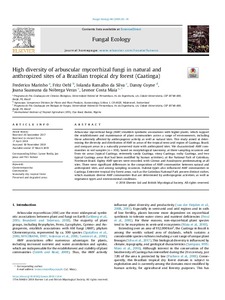| dc.contributor.author | Marinho, F. |
| dc.contributor.author | Oehl, F. |
| dc.contributor.author | da Silva, I.R. |
| dc.contributor.author | Coyne, D. |
| dc.contributor.author | da Nóbrega Veras, J.S. |
| dc.contributor.author | Maia, L.C. |
| dc.date.accessioned | 2019-12-04T11:34:02Z |
| dc.date.available | 2019-12-04T11:34:02Z |
| dc.date.issued | 2019-08 |
| dc.identifier.citation | Marinho, F., Oehl, F., da Silva, I.R., Coyne, D., da Nóbrega Veras, J.S. & Maia, L.C. (2019). High diversity of arbuscular mycorrhizal fungi in natural and anthropized sites of a Brazilian tropical dry forest (Caatinga). Fungal Ecology, 40, 82-91. |
| dc.identifier.issn | 1754-5048 |
| dc.identifier.uri | https://hdl.handle.net/20.500.12478/5874 |
| dc.description | Published online: 27 March 2019 |
| dc.description.abstract | Arbuscular mycorrhizal fungi (AMF) establish symbiotic associations with higher plants, which support the establishment and maintenance of plant communities across a range of environments, including those adversely affected by anthropogenic activity as well as natural sites. This study aimed at determining the diversity and distribution of AMF in areas of the tropical semi-arid region of Caatinga, Brazil, and compare areas in a naturally preserved state with anthropized sites. We characterized AMF communities in soil samples (n = 108), based on morphological taxonomy, at three sampling occasions and from six areas (typical Caatinga, extremely sandy Caatinga, stony Caatinga, rocky Caatinga, and two typical Caatinga areas that had been modified by human activities), at the National Park of Catimbau, Northeast Brazil. Eighty AMF species were recorded, with Glomus and Acaulospora predominating at all sites. There were significant differences in the composition of AMF communities between natural and anthropized sites, and among sampling occasions. Habitat-types also influenced AMF communities in Caatinga. Extensive tropical dry forest areas, such as the Catimbau National Park possess distinct niches, which maintain diverse AMF communities that are determined by anthropogenic activities, as well as vegetation types and environmental conditions. |
| dc.description.sponsorship | National Council for Scientific and Technological Development, Brazil |
| dc.format.extent | 82-91 |
| dc.language.iso | en |
| dc.rights | Copyrighted; all rights reserved |
| dc.subject | Communities |
| dc.subject | Tropical Forests |
| dc.subject | Fungi |
| dc.subject | Brazil |
| dc.subject | Arbuscular Mycorrhiza |
| dc.title | High diversity of arbuscular mycorrhizal fungi in natural and anthropized sites of a Brazilian tropical dry forest (Caatinga) |
| dc.type | Journal Article |
| dc.description.version | Peer Review |
| cg.contributor.crp | Roots, Tubers and Bananas |
| cg.contributor.affiliation | Universidade Federal de Pernambuco, Brazil |
| cg.contributor.affiliation | Agroscope, Competence Division for Plants and Plant Products, Ecotoxicology, Switzerland |
| cg.contributor.affiliation | International Institute of Tropical Agriculture |
| cg.coverage.region | Acp |
| cg.coverage.region | South America |
| cg.coverage.country | Brazil |
| cg.creator.identifier | Daniel Coyne: 0000-0002-2030-6328 |
| cg.researchtheme | NATURAL RESOURCE MANAGEMENT |
| cg.isijournal | ISI Journal |
| cg.authorship.types | CGIAR and developing country institute |
| cg.iitasubject | Forestry |
| cg.journal | Fungal Ecology |
| cg.howpublished | Formally Published |
| cg.accessibilitystatus | Limited Access |
| local.dspaceid | 105781 |
| cg.targetaudience | Scientists |
| cg.identifier.doi | https://dx.doi.org/10.1016/j.funeco.2018.11.014 |

